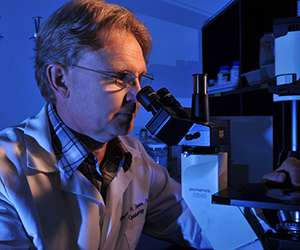Eye's recycling process key to seeing color, bright light

As many of us learned in high school science class, the retina's rods and cones allow us to see. Rods are for night vision, and cones operate in bright light and allow us to distinguish colors. But although scientists have an idea of what makes rods perform and flourish, they've been somewhat in the dark about what keeps cones working and thriving.
Researchers at Washington University School of Medicine in St. Louis believe they're now closer to the answer and that their findings may one day help preserve vision in patients with age-related macular degeneration and other retinal diseases.
They've identified in cone cells a cellular recycling process called autophagy that the cells need to function and, in some cases, survive. The researchers believe that if the recycling process can be activated with drugs, the approach may be used to treat or prevent some retinal diseases.
"If we can stimulate this pathway with drugs, we may be able to preserve vision in people with degenerative retinal diseases," said senior investigator Thomas A. Ferguson, PhD, a professor of ophthalmology and visual sciences. "The idea would be to stimulate the autophagy process and give cone cells more energy so that they could stay alive for as long as possible."
The study is published online in the journal Autophagy.
Ferguson explained that the autophagy process functions in two ways in cone cells.
"It helps cells survive in stressful situations, but it also functions at a baseline level," he said. "Proteins and organelles in the cell get old, and they have to be removed. Autophagy is the process that removes them so the cell can continue to function."
In previous research, Ferguson's team demonstrated that autophagy clears debris in the retina that is produced when rods and cones convert light into visual signals. In the new study, the researchers found that the process is key to the function of cone cells, allowing them to perceive color and continue sending signals when exposed to bright light.
In several experiments conducted in mice, Ferguson found that when the animals had no food for 24 hours, the process of autophagy became activated.
"Cone cells, like all neurons, need a lot of energy to function," he explained. "When the cells are stressed by starvation, the autophagy pathway is activated, and the cells temporarily digest their own proteins to survive. This process not only cleans out debris but allows the cell to use its own energy stores to keep sending visual signals even when there isn't any external energy to fuel it."
In other experiments, Ferguson's team studied mice missing a gene related to autophagy. When those mice didn't eat for 24 hours, their cone cells didn't activate the recycling process. As a result, the cells couldn't function, and the mice began to lose vision.
The scientists also discovered that mice without the autophagy gene in their cone cells could not adjust to bright light. Healthy cones survive and function in bright light, but the cells in mice without the gene could not.
"As light gets brighter and brighter, it may be uncomfortable, but we can still see," Ferguson said. "Even if you're in the Sahara Desert or some other place with intense sunlight, you can still distinguish shapes and colors. But when we took out the autophagy gene and exposed the mouse cones to bright light, the cells died."
Ferguson said the experiments demonstrate that autophagy is important to the function and survival of cone cells and, consequently, key to vision.
"Therapies that 'kick start' autophagy may prove valuable in treating degenerative retinal diseases," he said. "This is an avenue we plan to explore."
More information: Zhenqing Zhou et al. Autophagy supports color vision, Autophagy (2015). DOI: 10.1080/15548627.2015.1084456





















